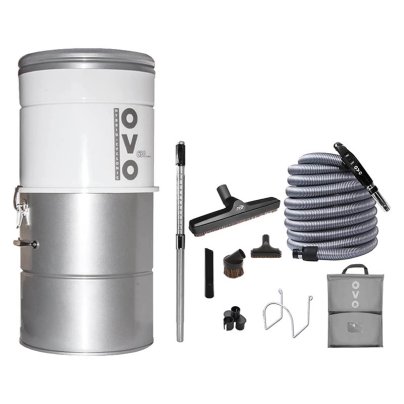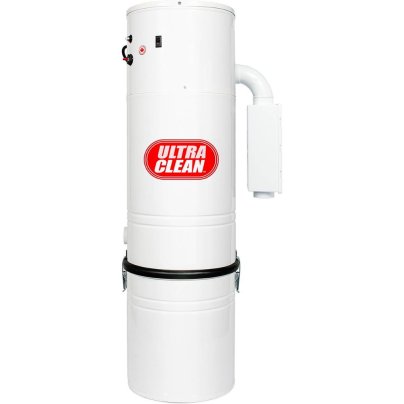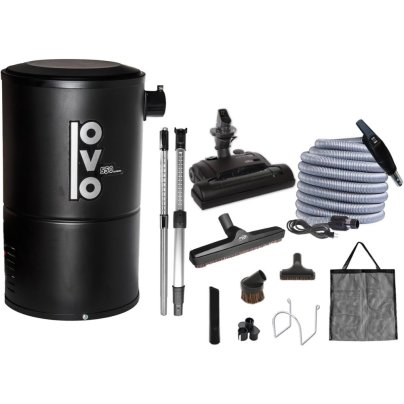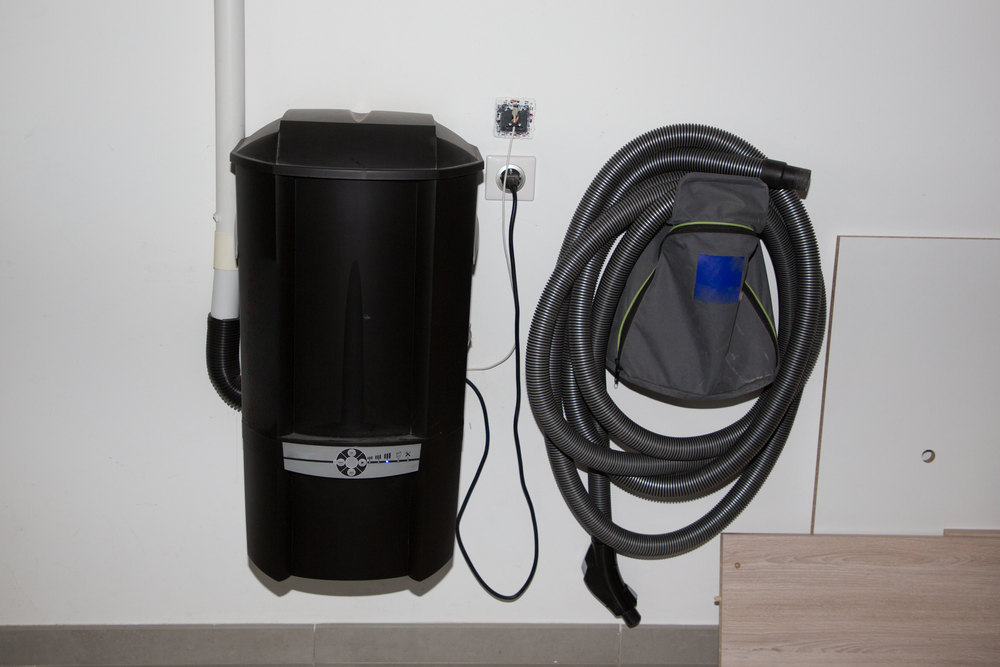
We may earn revenue from the products available on this page and participate in affiliate programs. Learn More ›
Vacuuming an entire house is a completely different chore when compared to vacuuming an apartment. It can be a hassle to not only carry a vacuum around (upstairs or downstairs), but it’s also annoying when there isn’t an available electrical outlet that’ll provide enough range to clean the area adequately without having to continuously unplug and replug in the vacuum to complete the job.
Central-vacuum systems (central vac) are a convenient way to avoid lugging around a heavy vacuum cleaner and dealing with troublesome power cords. Central- vacuum systems are equipped with a canister-style collection unit and central motor that attaches to a series of tubes throughout the home. The system has several inlets—typically one or two per floor of the home—where a central-vacuum hose can be connected for instant access to electricity and suction.
Continue reading for more information that can help shoppers find the best central-vacuum system to keep their home clean.
- BEST OVERALL: OVO Large Household Hybrid Central Vacuum System
- BEST BANG FOR THE BUCK: Ultra Clean SC200 Central Vacuum System
- BEST WITH HOSE: OVO 550AW-18L Compact Central Vacuum System
- BEST FILTRATION: Prolux CV12000 Central Vacuum Power Unit
- BEST FOR LARGE HOMES: OVO 35L Heavy-Duty Central Vacuum System
- BEST FOR RENTERS: OVO 595 AW Portable Vacuum System
- ALSO CONSIDER: Canavac Electric 756 Max AW Lamb Central Vacuum
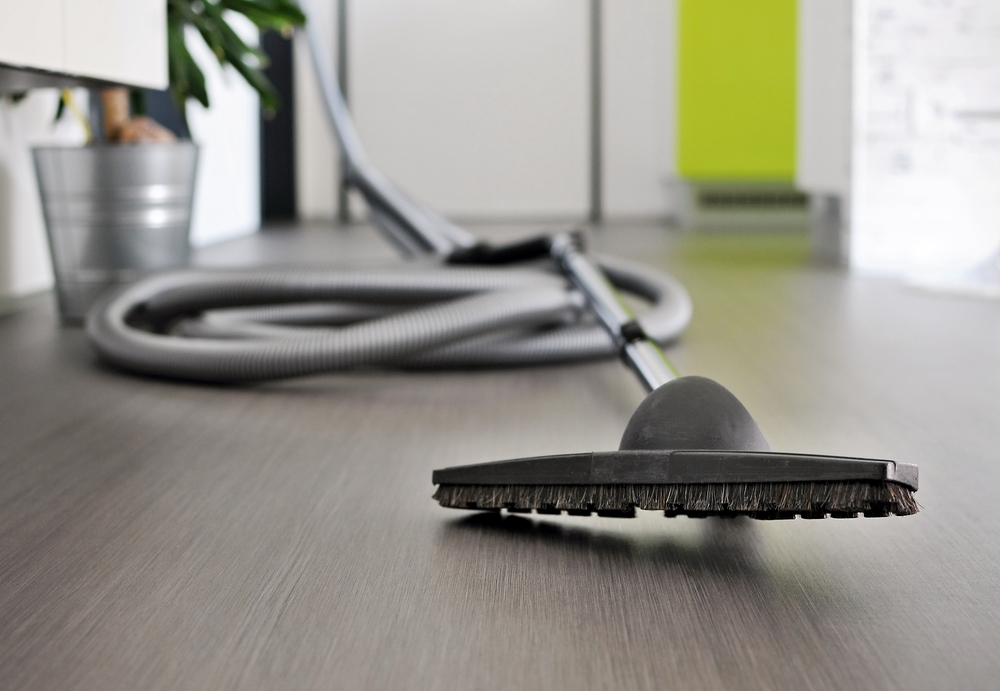
How We Chose the Best Central-Vacuum Systems
We researched the most sought-after central-vacuum systems in their respective categories and discovered that the best models are determined by their suction power, tank capacity, coverage area, attachments, and other special features included by top brands.
After extensive product research, we included whole-house vacuums in our list of top picks that had suction powers of 550 to 700 air watts and dust and debris capacities of 5.81 to 6 gallons for light- to heavy-duty cleaning. As for coverage area, many of these vacuum systems are capable of vacuuming up materials in 2,500- to 12,000-square-foot spaces, so there are options on the list that are able to suit most any home size.
Plus, many of these central-vacuum systems come with additional attachments like powered vacuum heads, crevice tools, dusting brushes, and more for a variety of cleaning tasks. Finally, many of these centralized vacuum cleaner top picks come with interior or exterior mufflers to reduce most any noise the vacuum system may generate.
Our Top Picks
We selected the top choices below based on the overall quality and efficacy of each product. Significant attention was given to important product factors such as power, filtration system type, noise, attachments, and installation to help users find the best central-vacuum system for their home.
Best Overall
OVO Large Household Hybrid Central Vacuum System
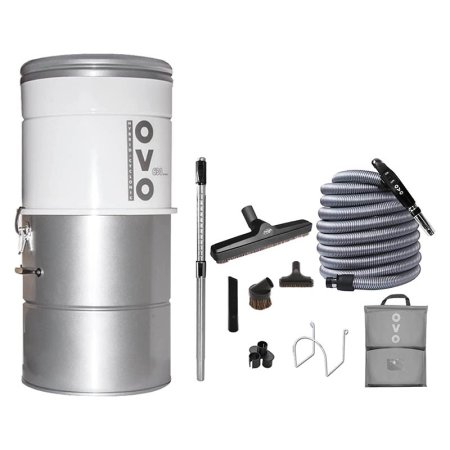
Pros
Cons
Product Specs
- Power output: 630 air watts
- Tank capacity: 6.6 gallons
- Compatible square feet: 7,500 square feet
Clean up any area of the home with the installation of this OVO model, a powerful central-vacuum system that uses a hybridized filtration and collection system, allowing it to collect dirt and debris with or without a vacuum bag. Using a bag just makes emptying the vacuum a bit easier, but it requires the added cost of replacement bags. The collection tank has a capacity of 6.6 gallons, and it’s built with an integrated muffler and noise-blocking foam around the motor for near-silent operation.
The vertical central-vacuum system operates at a power output of 630 air watts and 15 amps, making it suitable for up to eight inlets or about 7,500 square feet. It includes a 30-foot vacuum hose, a floor brush for vacuuming shallow carpets and hard surfaces, a crevice nozzle, a hose rack, a hose storage bag, and more.
Get the OVO large hybrid central-vacuum system at Amazon.
Best Bang For The Buck
Ultra Clean SC200 Central Vacuum System
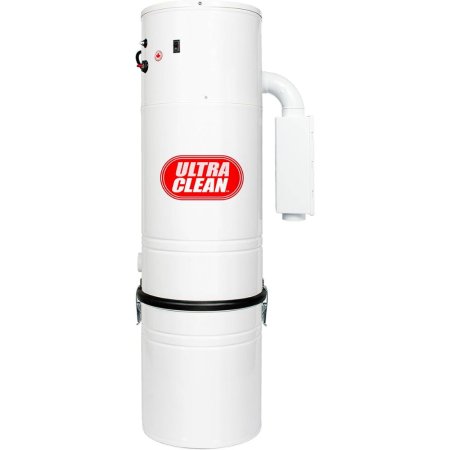
Pros
Cons
Product Specs
- Power output: 550 air watts
- Tank capacity: 5.81 gallons
- Compatible square feet: 7,500 square feet
The Ultra Clean central-vacuum system is an inexpensive option with premium features, such as the acoustic square muffler that extends out from the side of the vacuum canister, muffling the sound produced by the motor. It runs at 13.8 amps with an output of 550 air watts, which is enough power to service a home that’s 7,500 square feet or smaller.
The hybrid-collection filtration system allows the user to collect dirt, hair, dust, and other debris in the metal collection bin or attach a disposable vacuum bag and keep the collection bin neat and clean. However, keep in mind that this central-vacuum system only includes the main filtration and collection unit. It does not come with a vacuum hose or any accessories to actually vacuum the home.
Get the Ultra Clean central-vacuum system at Amazon.
Best With Hose
OVO 550AW-18L Compact Central Vacuum System
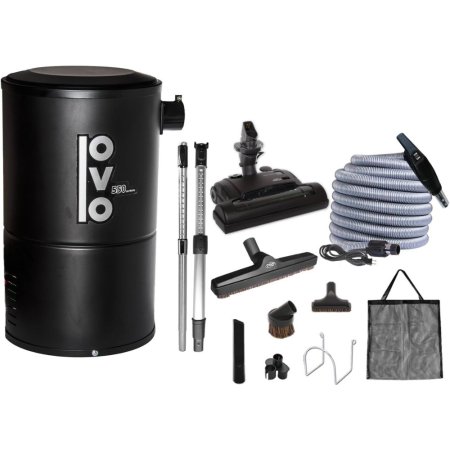
Pros
Cons
Product Specs
- Power output: 550 air watts
- Tank capacity: 4.74 gallons
- Compatible square feet: 4,000 square feet
This impressive central-vacuum system and accessory kit is a great choice for anyone who’s installing a new central-vacuum system instead of just replacing a worn-out old system. It comes with a 30-foot vacuum hose, a crevice nozzle, a dusting brush, a combo brush, upholstery brush, a chrome hose hanger, an accessory bag, and two telescoping handles that attach to a powered vacuum head and a floor brush.
With its 4.74-gallon filtration and collection chamber, this central-vacuum system is equipped with an integrated muffler and noise-dampening insulation around the motor for quiet operation. It has a powerful 550 air watts of output, making it suitable for homes up to 4,000 square feet in size.
Get the OVO 550AW-18L central-vacuum system at Amazon.
Best Filtration
Prolux CV12000 Central Vacuum Power Unit
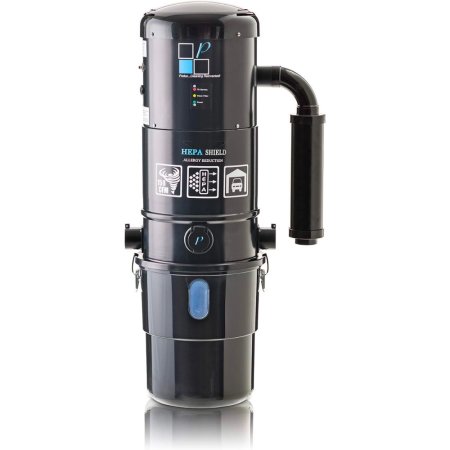
Pros
Cons
Product Specs
- Power output: 2,029 air watts
- Tank capacity: 5 gallons
- Compatible square feet: 7,500 or 12,000 square feet
Install the Prolux central-vacuum system to help improve the quality of the air in the home. The bagless system is equipped with a micron and HEPA filter to ensure that small particles and irritating allergens are caught in the filter as they pass through into the 5-gallon debris-collection bin. Both filters can be hand-washed, dried, and reused, so users don’t need to worry about replacing them.
This vacuum system includes an exterior muffler to help reduce the noise created by the powerful motor, which can produce a suction power of up to 2,029 air watts. The manufacturer states that this vacuum is suitable for homes up to 12,000 square feet. However, comparable products are only intended for up to 7,500 square feet, so the system may not actually be appropriate for larger homes.
Get the Prolux central-vacuum system at Amazon, Lowe’s, Walmart (in red), or Target (in red).
Best for Large Homes
OVO 35L Heavy-Duty Central Vacuum System
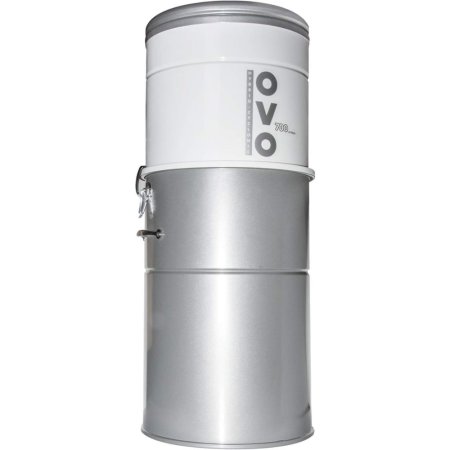
Pros
Cons
Product Specs
- Power output: 700 air watts
- Tank capacity: 9.25 gallons
- Compatible square feet: 9,000 square feet
With its huge 9.25-gallon debris-collection bin, the OVO heavy-duty central-vacuum system can hold a lot of dust and dirt. With its 700-air-watt motor, it’s capable of taking care of up to 9,000 square feet. Despite its large size, it isn’t overly loud thanks to an integrated muffler and noise-blocking foam that surrounds the motor.
The OVO works with or without disposable bags and includes a filter that’s machine washable. This vacuum system uses soft-start technology that helps extend the life of the motor, and the motor will also delay 3 seconds when turned off to ensure that no dust or dirt is left in the hose. Other features include an LED indicator that illuminates when the collection bag is full and sturdy rolled-steel construction.
Get the OVO heavy-duty central-vacuum system at AmazonorOVO.
Best for Renters
OVO 595 AW Portable Vacuum System
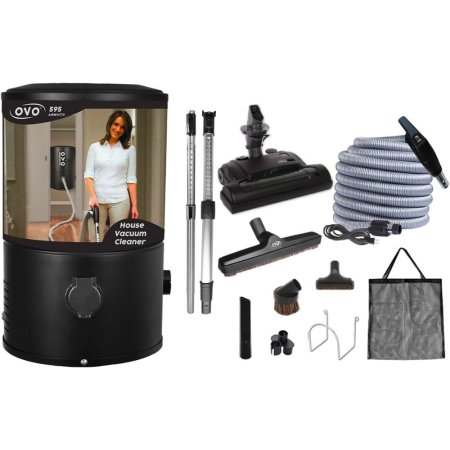
Pros
Cons
Product Specs
- Power output: 595 air watts
- Tank capacity: 4.75 gallons
- Compatible square feet: 1,600 square feet
Most central-vacuum systems use pipes that run through the walls to reach all parts of the home. This wall-mountable model from OVO is an exception. It uses a 40-foot hose that extends from the base throughout the house, which is enough length to cover about 1,600 square feet of floor space.
Since it doesn’t require pipes, the OVO portable vacuum system is a great option for renters or for those who don’t want to go through the hassle and expense of retrofitting their home with vacuum pipes. It produces 595 air watts of suction, similar to other systems, and comes with a 4.75-gallon capacity canister. There’s also a convenient on/off switch on the handle, so the operator doesn’t have to return to the base to turn it on and off. This system comes with an accessory kit that includes a variety of vacuum attachments.
Get the OVO portable central-vacuum system at Amazon or OVO (without accessory kit).
Also Consider
Canavac Electric 756 Max AW Lamb Central Vacuum
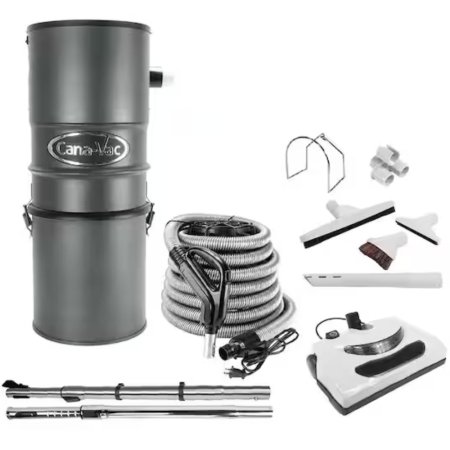
Pros
Cons
Product Specs
- Power output: 756 air watts
- Tank capacity: 4 gallons
- Compatible square feet: N/A
With a powerful two-stage motor that produces 756 maximum air watts, the Canavac Lamb is one of the most powerful central-vacuum systems one can add to a home. It’s also ideal for removing allergens thanks to a permanent micro filter and HEPA bag system. While it is more powerful than other systems, it also offers a smaller 4-gallon collection container, so it will require bag changes or emptying more often.
The Canavac Lamb can be used as a bagged or bagless vacuum. It comes with a 30-foot vacuum hose and allows the user to turn the system on and off from the handle. It includes nine cleaning attachments as well.
Get the Canavac central-vacuum system at The Home Depot.
Jump to Our Top Picks
What to Consider When Choosing a Central-Vacuum System
Before selecting a central-vacuum system, savvy shoppers often take the time to decide what features are the most important to them, which could include the air watts, filtration system, noise level, ease of use, and whether or not the unit comes with additional attachments to make vacuuming the home easier. Keep reading for detailed information on these product factors and more.
Air Watts and Power
The power of a central-vacuum system is typically measured in air watts. To determine the air watts of a central vac, multiply the airflow in cubic feet per minute by the water lift in inches, and divide the total by 8.5. Here’s the equation:
(airflow x water lift)/8.5 = air watts
Water lift refers to the central-vacuum system’s ability to suck liquids through the system, while the airflow describes the system’s ability to pull air into the system. The amperage of the vacuum cleaner can also influence the overall power of the system. The higher the amperage rating, the more powerful the vacuum.
Just keep in mind that a farther distance between the inlet receptacle and the central vacuum motor indicates that the vacuum will have a lower power level there, so large homes may experience reduced air watts on the top floor when compared to the power output on the main floor of the home.
Collection and Filtration System
When it comes to collection and filtration, central-vacuum systems have a range of different options, including bagged, bagless, vertical, cyclonic, and inverted.
- Bagged systems have disposable vacuum bags to collect the dust, dirt, hair, and other debris from the home. When the bag gets full, it needs to be replaced; otherwise, the power and air watts of the vacuum become severely reduced and the motor can burn out.
- Bagless systems collect the same dirt and debris as a bagged system, but instead of relying on a disposable bag, the vacuum pulls the debris into a collection chamber. The collection chamber still needs to be emptied regularly to avoid the same problems that can occur with a full vacuum bag.
- Vertical central-vacuum systems typically use vacuum bags. The airflow and debris are sucked down into an upright collection system, trapping dust, dirt, hair, and more in a bag for disposal.
- Cyclonic central-vacuum systems make use of centrifugal force to help separate dirt clumps, hair, and other debris as it enters the collection tank. These systems are typically bagless, sucking the dirt into the canister for disposal.
- Inverted central-vacuum systems resemble vertical systems, except that the air is pulled up and across the vacuum filter instead of down into it. This difference uses gravity to help keep the filter clean as dust, dirt, and other particles drop down off of the filter into the collection tank below when the system is turned off.
Noise
One of the more appealing features of a central-vacuum system is that it doesn’t produce a lot of noise. This is primarily because the motor and collection tank are typically located in a basement, garage, or closet, where the sound is muffled. However, if the vacuum is being used and anyone in the home is close to the central collection tank, the ongoing drone of the motor could get irritating.
Look for a central-vacuum system with noise-blocking filters and thick collection tanks to help dampen and reduce the amount of sound produced by the vacuum if the intended location of the collection tank is close to a home office or a basement bedroom.
Attachments
Like most vacuums, central-vacuum systems can come with a wide range of accessories that help users get into tight corners, reach overhead, suck up liquids, clean upholstery, and more. These accessories can include crevice nozzles, elbow wands, wet nozzles, brush nozzles, hose extensions, and powered vacuum heads.
- Crevice nozzles are long, thin attachments that help suck up debris in tight corners and crevices around the home.
- Elbow wands connect to the hole to help shorter individuals vacuum spiderwebs from ceiling corners and reach the tops of floor-to-ceiling curtains.
- Wet nozzles have a squeegee edge to help collect and suck up liquids. The squeegee pulls the water in, and the nozzle sucks it into the vacuum system.
- Brush nozzles are also referred to as upholstery tools because they’re intended to clean upholstery, like curtains and some furniture. However, this tool is very helpful for vacuuming car interiors as well.
- Hose extensions can be flexible or rigid, and the entire purpose of these accessories is to give the user a little extra length to the end of the hose.
- Powered vacuum heads allow users to vacuum the carpets as if they were using a standard vacuum instead of a central-vacuum system. These accessories consist of a powered vacuum head that connects to an upright, hollow suction tube. Just attach the central-vacuum hose to the tube to power this device and start vacuuming the floors with ease.
Installation
Unfortunately, one of the primary obstacles for most people when it comes to a central-vacuum system is the installation. As mentioned, the central-vac tubing needs to run inside the walls of the home, from the central-vacuum motor and collection tank to every floor, so users may need a professional central-vacuum installer to complete the installation.
If users choose to install the system for themselves, it’s important to note that central-vac tubing is not the same as a drainpipe, despite the comparable appearance. The system should also have at least one valve inlet on every floor, with most floor plans requiring one inlet for every 750 square feet. These inlets include a low-voltage coupler that triggers the on/off switch at the motor.
FAQs
Central-vacuum systems make an excellent addition to the home if you don’t want to have to carry a vacuum around the house or deal with power cords. Even after reviewing the details above, you may still have a few questions about how to clean the central vac or how long it will last. Continue reading for answers to some of the most commonly asked questions about the best central-vacuum systems.
Q. How do I clean my central-vacuum cleaner?
A central-vacuum cleaner is essentially a single collection and filtration tank and a series of tubing that runs throughout the home. To clean the tubes, use a central vacuum cleaning cloth, which is a specially designed product that needs to be sucked into the vacuum hose and tubing and retrieved at the central canister. Repeat this process at every inlet receptacle.
Empty the central canister and replace the vacuum filter if necessary. Some filters are reusable, so they just need to be cleaned in a bucket of soapy water, rinsed, and allowed to dry before being reinserted into the vacuum.
Q. How long will my central-vacuum cleaner last?
A central vacuum tends to last about 20 years, while the life of a hose and any additional accessories varies depending on the specific product and individual usage.
Q. How many air watts should I look for in a good central-vacuum cleaner?
A quality central-vacuum system should be able to produce between 500 and 800 air watts. This is enough suction for homes that range from 2,000 to 6,000 square feet.
